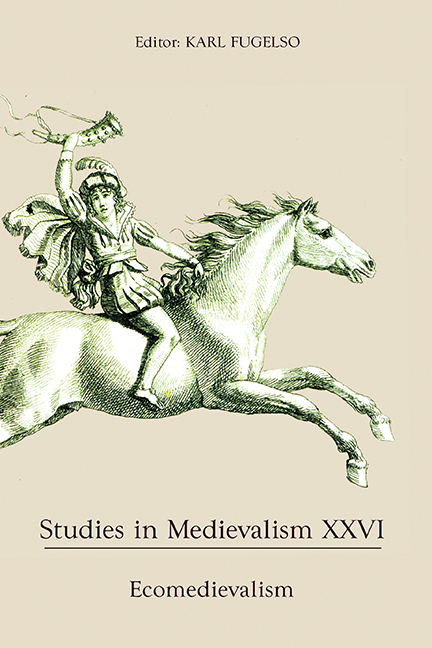Book contents
- Frontmatter
- Studies in Medievalism
- Acknowledgments
- Contents
- List of Illustrations
- Editorial Note
- I Ecomedievalism: Some Perspective(s)
- “A Sense of Life in Things Inert”: The Animistic Figurations in Nineteenth- and Twentieth-Century Medievalist Texts
- Future Nostalgias: Environmental Medievalism and Lanier's Southern Chivalry
- T. H. White's “Forest Sauvage”: Nostalgia and Loss
- Elvencentrism: The Green Medievalism of Tolkien's Elven Realms
- II Interpretations
- Contributors
- Miscellaneous Endmatter
“A Sense of Life in Things Inert”: The Animistic Figurations in Nineteenth- and Twentieth-Century Medievalist Texts
from I - Ecomedievalism: Some Perspective(s)
Published online by Cambridge University Press: 15 September 2017
- Frontmatter
- Studies in Medievalism
- Acknowledgments
- Contents
- List of Illustrations
- Editorial Note
- I Ecomedievalism: Some Perspective(s)
- “A Sense of Life in Things Inert”: The Animistic Figurations in Nineteenth- and Twentieth-Century Medievalist Texts
- Future Nostalgias: Environmental Medievalism and Lanier's Southern Chivalry
- T. H. White's “Forest Sauvage”: Nostalgia and Loss
- Elvencentrism: The Green Medievalism of Tolkien's Elven Realms
- II Interpretations
- Contributors
- Miscellaneous Endmatter
Summary
One of the more predictable tropes of nineteenth- and twentieth-century medievalist literature is the animistic figurations scattered throughout those texts. Indeed, the presence of such figuration is so commonplace in the medievalist oeuvre as to seem unnoteworthy, and yet an investigation into the various forms that such figuration takes reveals a good deal of insights into both medievalism and contemporary ecocritical discourses. Whether it is Guinevere describing “the Spirits of the waste and weald” mourning her departure from Camelot in Tennyson's Idylls of the King or Sieur Louis de Conte in Mark Twain's Personal Recollections of Joan of Arc describing “The Fairy Tree” of Domremy, the natural world is represented repeatedly in these texts in animistic terms. That is, these texts routinely describe the natural world, including animals, vegetation, even rocks and water, as having some form of sentience. This figuration often occurs through anthropomorphic and zoomorphic images that blur the line between the nonhuman and human worlds. However, it also includes the depiction of the nonhuman as sacred, the representation of elemental figures such as sprites and gnomes, and the imaginative synthesis of humanity with the nonhuman, such as in mythological figures like fauns, centaurs, and sphinxes. The animistic figurations, however they are rendered, suggest that nonhuman beings are not merely inanimate objects but conscious, intelligent, willful beings.
There exist at least three ways in which medievalist texts employ these animistic figurations, the first of which relates to the Romantic medievalism so entwined with nineteenth-century political discourses. This form uses animism as a means of animating not only the constituents of a given nation but also the nation itself, as a geographical locale. It uses a particular natural object, such as an animal, a tree, or a natural landmark, as a symbol of a given nation. A clear example of this would be the representation of the Rhine in Wagner's Der Ring des Nibelung, in which the Rhine is anthropomorphized as three maidens who guard the golden ring central to the operas’ narrative. The opening scene of the first opera, Das Rhinegold, begins with a prelude in which Wagner varies the E-major scale to create the sense that the Rhine itself is singing.
- Type
- Chapter
- Information
- Studies in Medievalism XXVIEcomedievalism, pp. 3 - 10Publisher: Boydell & BrewerPrint publication year: 2017

